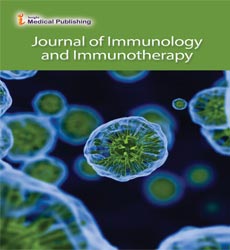Editorial Note on Immunoinformatics
Ethan Fisher*
Editorial office, Journal of Immunology and Immunotherapy, United Kingdom
- *Corresponding Author:
- Ethan Fisher Editorial office, Journal of Immunology and Immunotherapy, United Kingdom E-mail: jmso@emedicinejournals.org
Received Date: June 07, 2021; Accepted Date: June 15, 2021; Published Date: June 28, 2021
Citation: Fisher E (2021) Editorial Note on Immunoinformatics. J Immuno Immnother Vol.5 No.3:14.
Editorial Note
Clostridium perfringens is a bacterium found in the Gastro- Intestinal Tract (GIT) of both sick and healthy people and animals. In addition, this bacterium is responsible for 5–15% of all antibiotic-associated diarrhoea cases, which occur in 5%-40% of all antibiotic-treated patients. It also causes enteritis necroticans, a human condition that is typically fatal. Although C. perfringens is well-known, the underlying mechanisms that cause various characteristics of disease are unknown. Using immunoinformatics methods, this study predicts an efficient epitope-based vaccine against Clostridium perfringens fructose 1,6-biphosphatealdolase (FBA) enzyme.
The sequences were obtained from NCBI, and numerous prediction tests were run to look for potential epitopes for B-cell, T-cell, and MHC class I and II MHC molecules. The most promising epitopes' tertiary structure was discovered. B-cells showed high binding affinity for 48 epitopes, while MHC I and MHC II showed high binding affinity for five epitopes. The findings suggested that a vaccination with population coverage of more than 98% may be developed. We hope that these potential epitopes will be used as a disease prevention measure in the future, and we propose further in-vivo and in-vitro research.
Plasmodium falciparum is one of four parasite species found in humans, all of which belong to the genus Plasmodium. It is responsible for 50% of all malaria cases worldwide. It is the deadliest, accounting for 98% of all fatalities. Because no prior reports of an effective epitope-based vaccine against Plasmodium falciparum TCTP enzymes had been reported, this study used immunoinformatics to predict an effective epitopebased vaccine against P. falciparum TCTP enzymes. The TCTP sequences of Plasmodium Falciparum were obtained from the National Center for Biotechnology Information (NCBI) database. To predict B-cell, T-cell MHC class I and II, the conserved areas were added to the IEDB analysis database. The most promising epitope's 3D structure was discovered. SYVQQDPFE, a proposed and promising peptide, exhibited a strong binding affinity to B-cell, MEAGIIYSY, which showed a strong binding affinity to MHC I alleles, and IYSYYKGEEITPRFV, which showed a strong binding affinity to MHC II alleles. The findings indicated that a vaccination with more than 93.73% global coverage and 82.13% in Sudan may be developed, omitting particular MHC II alleles. The most promising peptides as universal vaccines should be evaluated in-vivo and in-vitro, according to this study. The sequences were obtained from NCBI, and numerous prediction tests were run to look for probable epitopes for B-cell, T-cell, and MHC class I and II MHC class I and II.
The most promising epitopes tertiary structure was discovered. B-cells showed high binding affinity for 48 epitopes, while MHC I and MHC II showed high binding affinity for five epitopes. The findings suggested that a vaccination with population coverage of more than 98% may be developed. The TCTP sequences of Plasmodium falciparum were obtained from the National Center for Biotechnology Information (NCBI) database. To predict B-cell, T-cell MHC class I and II, the conserved areas were added to the IEDB analysis database. The most promising epitope's 3D structure was discovered. The most promising peptides as universal vaccines should be tested in-vivo and in-vitro, according to this study. The sequences were obtained from NCBI, and numerous prediction tests were run to look for probable epitopes in the MHC class I and II tertiary structure of B-cells and T-cells.
Open Access Journals
- Aquaculture & Veterinary Science
- Chemistry & Chemical Sciences
- Clinical Sciences
- Engineering
- General Science
- Genetics & Molecular Biology
- Health Care & Nursing
- Immunology & Microbiology
- Materials Science
- Mathematics & Physics
- Medical Sciences
- Neurology & Psychiatry
- Oncology & Cancer Science
- Pharmaceutical Sciences
